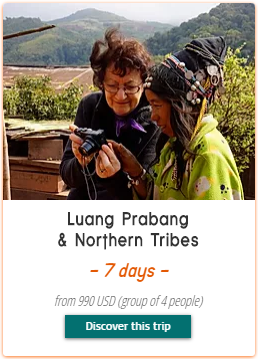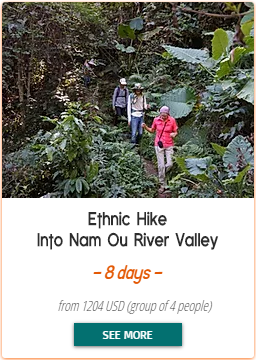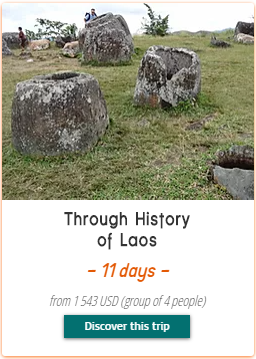Focus on Laotian handicraft : Silk weaving at Ock Pop Tok
- Charly Renaudin

- Oct 4, 2019
- 6 min read
Updated: Jul 24, 2020
Handicraft is an important part of a country’s culture. It’s linked to its daily life, its history and its people. Northern Laos is still a rural area, thus, several objects are still homemade. Bamboo baskets, silk scarves, mulberry paper are few examples of these very rich ethnic traditions. How do they make it? How it’s linked to their daily life? Why do they keep doing it whereas it’s not needed anymore? How is this science transmitted? So many questions that we will answer. As it’s not our field of knowledge, we asked for help from experts. In this article, we focus on silk weaving with Rachna & Sengchan from Ock Pop Tok. Enjoy the reading !

Sabaidee Rachna & Sengchan. Can you briefly introduce Ock Pop Tok to us? And what is the living crafts center ?
Ock Pop Tok is a pioneering artisan social enterprise that produces handmade textiles and handicrafts. We provide meaningful cultural experiences for visitors. Operating on a platform of fair trade, we work directly with weavers and artisans, here in Luang Prabang and in villages across Laos.
Ock Pop Tok means "east meets west" and combining traditional skills with modern design and colors is part of what we do. Founded by two friends—Veomanee Duongdala, a Lao weaver, and Joanna Smith, an English photographer—we have been part of Luang Prabang community since 2000. We like to think we are a company created by women and run by women for the women of Laos.
The Living Crafts Center is our creative learning centre on the banks of the Mekong River. Our weaving studio, café and one of our shops is located here. We also offer hands-on classes in silk, cotton and bamboo weaving, natural dyeing and Hmong batik. We believe that just like you can discover a culture through its food, you can also discover Laos through textiles. The Living Crafts Centre was inspired by this idea. Here you can do everything from learning how to weave, meeting our weavers, eating our healthy, locally-sourced Lao fusion food, taking a free tour around the studio and gardens, or to under or chilling in a treehouse and watching river life unfold on the Mekong -- these are all part of the Luang Prabang lifestyle and discovering Laos through textiles!
Can you tell more about silk weaving ?
What kind of objects can you make using silk weaving ?
Silk is rare and time-consuming to make, particularly when its handmade. That’s why we use it only for special, ceremonial clothes. In the past, silk was reserved for making sinh, or the traditional skirt worn for weddings or for special temple wall-hangings. Cared for properly, handwoven silk textiles can last for decades, and were often passed down as heirlooms. At Ock Pop Tok, we use raw, handloomed silks to weave sinh, scarves, wall hangings and traditional ceremonial blankets.
Before weaving the silk, you have to get the silk. Could you tell us more about this process ?
To get silk, you first need worms. At the very beginning, you have an egg. Once the worm emerges from it, it feeds on large amounts of mulberry leaves and gets very fat. Then. it spins a cocoon of one continuous thread. When it has completed cocoon, it takes it around 3-4 days to transform into a moth. The moth breaks open the cocoon, flies away, finds a partner, and makes more eggs. To get the silk, we take a cocoon, boil it and lift this one long silk thread out of each cocoon. It is then washed and spun by hand to get the fibre needed to weave.
We buy our raw silk from local silkworm producers Northern Laos, but also Thailand and Vietnam. Depending on the climate where silkworm is raised, the silk fibre will be different. Both in texture and colour. The yellow fibres comes from warm areas, whereas the white one is linked to a colder climate.
Each cocoon has 3 different layers of silk. The outer one is thick, we use this for warm scarves. The middle one, has a better quality, perfect for making traditional long skirts or sinh. Finally, the inner one is the most precious one. We select it for the ceremonial blankets.
What is the process to weave silk? What are the specific tools required ?

Once you have the raw silk from the cocoon, you have to dye it. For that, we soak it in water with natural pigments. But we also need to fix the colors, so as it doesn’t disappear when you wash your scarf or your sin.
That’s why we use a “fixant”, which is also natural. For each color, there is a combination of a pigment and a “fixant”. For example, for a certain yellow, we use jackfruit for the color, and alum rock to fix it.

Once the silk fibres have been dyed, it is ready for weaving. It’s time to go to the loom. There are 4 main techniques to create patterns. Obviously, the simpler the patterns, the quicker the weaving.
To give an idea, a sinh takes around 2 weeks to be made, a scarf around 1 week. The most complicate stuff to create is the traditional Tai Deng wedding blanket using a specific technique. The master weaver will progress only 10 cm per day !
Is weaving specific to a particular area of Laos? Can you tell us the differences depending of the ethnic group?
Weaving is not specific to a certain ethnic group. However, each tribe has its own way of dyeing and weaving. For example, Hmong people use wooden pots to soak their silk, whereas Tai Lue use a terracotta one. Moreover, Hmong use only hemp, not silk.
The themes and patterns are also very different from one ethnicity to another. Birds, elephants, butterflies, they all have a meaning according to the ethnic group wearing it. For instance, the Buddhist dragon snakes, known as “naga”, are a symbol of protection for Tai Lue people.
How is this craft transmitted from elders to youngers?
As for many handicrafts, this art is transmitted orally from elders to youngers. To be more specific, the mother teaches her daughter how to weave. Traditionally, only women weave. The girls start to learn around 7 or 10 years old. And they start mastering the technique when they are 12 or 15, meaning that it takes around 5 years to learn.

There is an interesting story that I want to tell you. In northern Laos, the Tai Daeng ethnic groups are masters of silk weaving. Traditionally, when a wedding occures, the bride has to weave the ceremonial clothes. Making the costume, sinh, traditional scarf or pha bieng, and wedding blanket can take her up to 6 months. They can’t get married until she has weaved everything. The groom can use this time period to build their future home 😊
Have you seen the interest about handicraft increasing from tourists in the past few years ?
I think tourists are always interested in supporting local businesses and take part in meaningful cultural experiences. It seems people are generally more curious about handmade, low-impact, slow-life ethos. In this respect, I think travelers are definitely seeking out handicrafts, artists and creatives - be it in food or textiles or performing arts. Also, folks want to take back a memento from their travels, something reflects the culture of the place they've been. Handicrafts are a perfect way to support local livelihoods and return home with a meaningful souvenir.
What kind of activity/workshop do you offer to share this knowledge?
We offer a free tour that explains the lifecycle of textiles - from silkworms and cotton to the entire handmade process that goes into making a beautiful woven piece.
Travelers can enroll in hands-on handicraft classes that go from 2 hours to 1/2 day or full day classes. Each class is led by an English-speaking guide and a master artisan.
Aside from learning the craft, you make friends with your guides and learn about their lives and experiences !
The Silk Road Café is an atmospheric riverside spot to sample our menu, which is inspired by Silk Road cultures and ingredients.
Lao textiles are the medium for transmitting the stories and folktales of Lao culture. Stop by our shop at the LCC and our two shops in town, and our staff will tell you the fascinating myths and legends woven into Lao textiles.

We would like to thank Rachna & Sengchan from Ock Pop Tok for all these details. It’s so pleasant to hear an expert talking about what she loves. You can follow their actions on Facebook & Instagram, or contact them by email contact@ockpoptok.com. We hope that, through this article, you have learnt a lot about this particular type of handicraft. And if you are curious about pottery, bamboo weaving, or mulberry paper making, stay tuned ! Moreover, if you want us to organize your trip in Laos and make you discover local culture, feel free to contact us. See you soon.
#weaving #weaver #silk #silkworm #handicraft #craft #ockpoptok #laos #luangprabang #tradition #culture #dying




















Comments